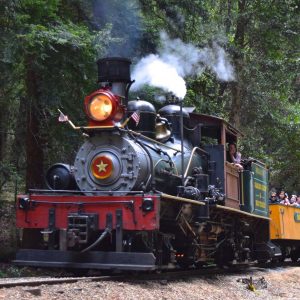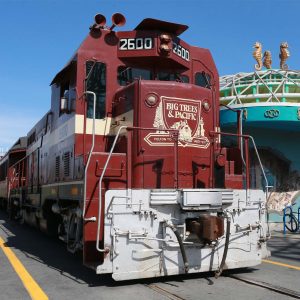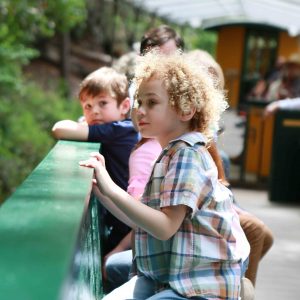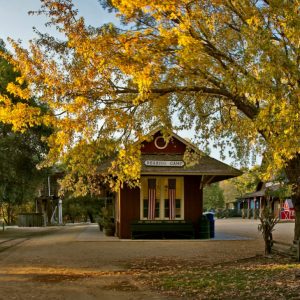Roaring Camp Railroads
Where History Comes to Life – The Story of Roaring Camp
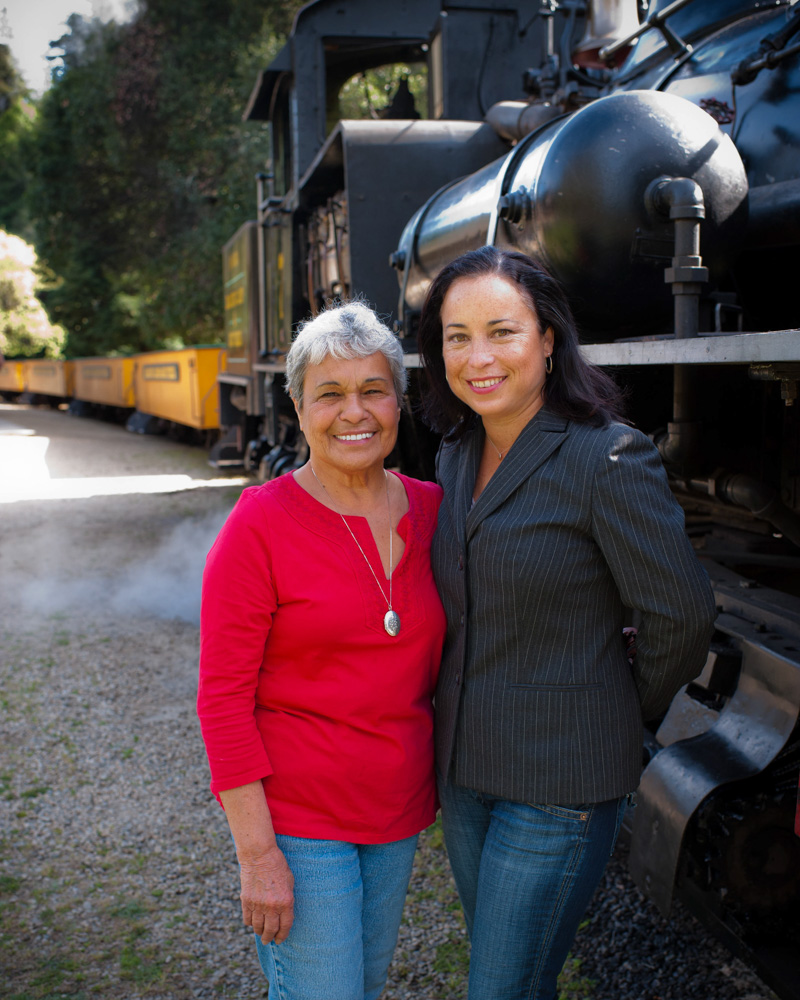
ROARING CAMP RAILROADS, EST. 1963
Mountain man, Isaac Graham, settled here in the 1830s. Soon after, Mexican authorities named Graham’s wild settlement “Roaring Camp.”
In 1842, Graham established the first saw mill west of the Mississippi. Fortunately, the Big Trees here were spared the woodman’s axe, and 25 years later became the first virgin stand of coastal redwoods to be protected from logging.
The area’s first railroad, the Santa Cruz & Felton, began carrying tourists to the Big Trees and the beach in 1875. In 2013, the Roaring Camp & Big Trees Narrow Gauge RR celebrated its Golden Anniversary (50 years) and the Santa Cruz, Big Trees & Pacific RY has been operating along the 1875 Santa Cruz & Felton route since 1985.
The dream of preserving a piece of the 1880s and early California was the dream of Roaring Camps Founder F. Norman Clark. Tragically in December 1985, Norman Clark passed away of pneumonia resulting from his selfless work to open the Santa Cruz, Big Trees & Pacific Railway. His wife, Georgiana, the longtime Vice President of Operations was elected chief executive officer by the respective board. Georgiana passed away in 2012 but not before she was awarded with the San Lorenzo Businesswoman of the Year Award, an NTA Pioneer Award and The California Travel Industry’s Lifetime Achievement Award.
Today, Melani Clark, daughter of Roaring Camp Founder, F. Norman Clark and Georgiana serves the company as its CEO continuing to preserve a piece of the 1880’s and early California that was the dream of Founder, F. Norman Clark.
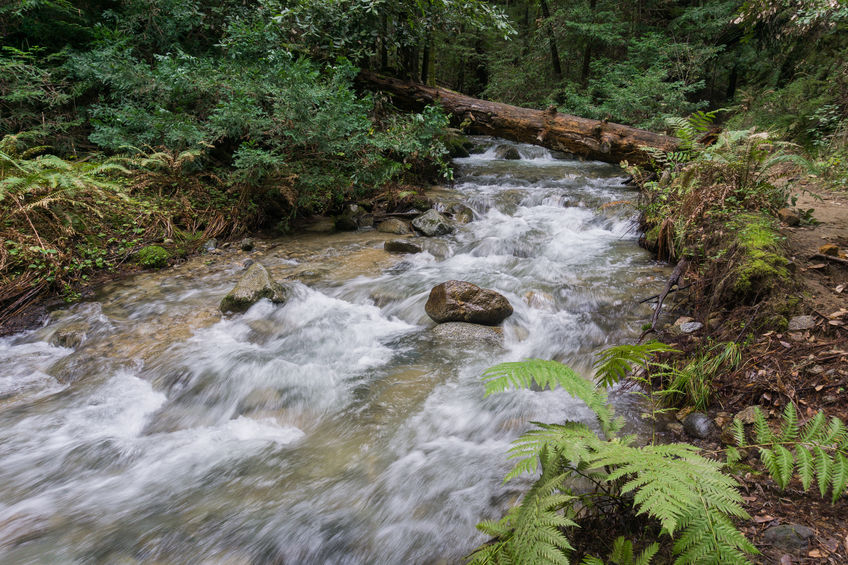
FELTON, CALIFORNIA
Among geared locomotives, three companies (Shay, Heisler and Climax) are widely credited with dominating the logging and industrial marketplace. Shay locomotives were designed in 1872 particularly for Western U.S. logging operations.
Roaring Camp Railroads owns several Shay locomotives, a Heisler, Climax, and five diesel engines. Not all are operational as some are undergoing renovation and extensive refurbishing. On any given day, one might see one or more of the following steam locomotives transporting visitors deep into the heart of the breathtaking Santa Cruz Mountains.
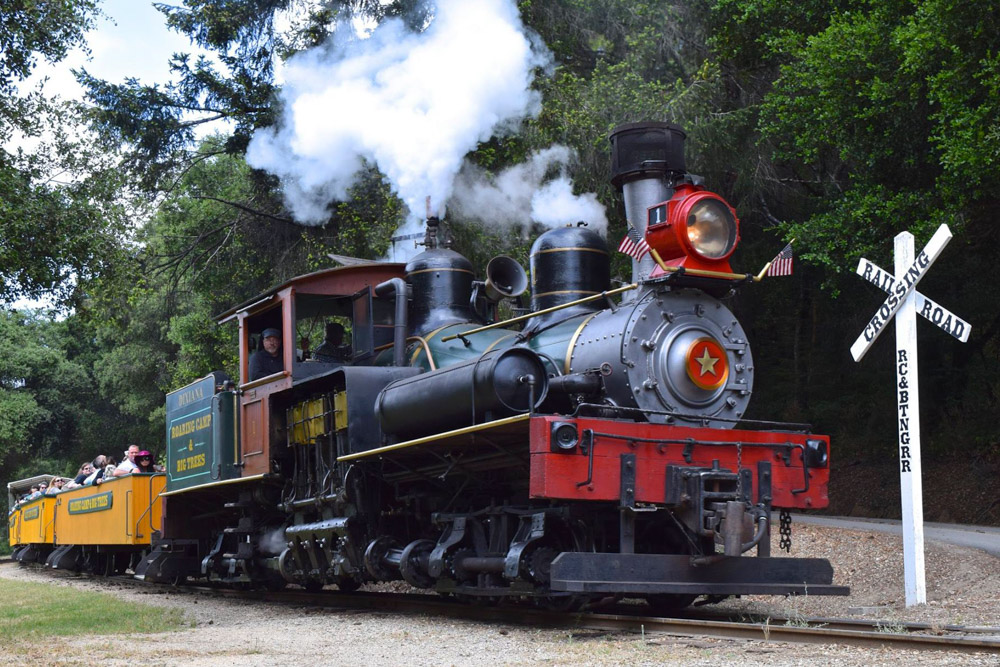
DIXIANA SHAY
The Dixiana, Roaring Camp Engine #1, is one of three engines designated a National Mechanical Engineering Historical Landmark.
The Dixiana has an historic and varied past. The “Dixie,” as she is affectionately called, was built by Lima Locomotive Works, Shop No. 2593, on October 12, 1912. She served on six different short line railroads before coming west to California. Although she saw service on the famous Smokey Mountain Railroad in Tennessee, it was a little narrow-gauge mining railroad (now abandoned) in Dixiana, Virginia, that gave her the name “Dixiana.”
A two-truck engine, the Dixie weighs 42 tons with a tractive effort of 17,330 lbs. and has 29 ½” drivers. Three 10 x 12 inch cylinders can maintain 180 pounds working pressure.
The beloved Dixie was dubbed Roaring Camp Engine #1 because it was the first locomotive acquired by founder, F. Norman Clark, who inaugurated steam train service from Roaring Camp on April 6,1963.
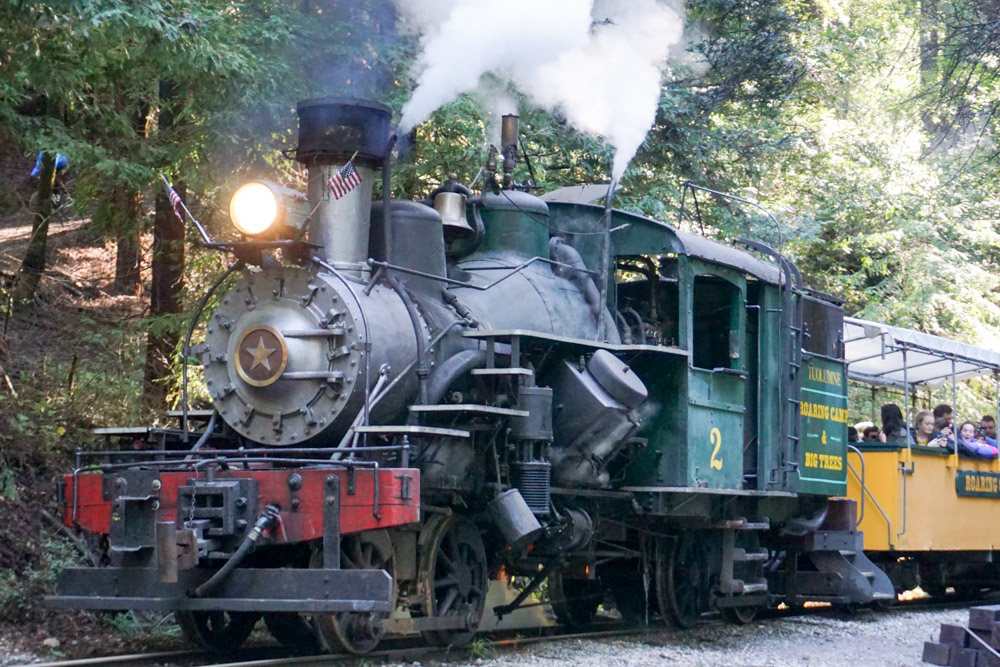
TUOLUMNE HEISLER
Named “Tuolumne,” Roaring Camp’s Heisler Engine No. 2 was ordered by the Hetch Hetchy & Yosemite Valleys Railroad in 1899 to operate at the West Side Flume & Lumber Company Sawmill near Tuolumne City, California.
When she was saved from the scrap heap and purchased in 1962 by Roaring Camp & Big Trees for $7,000, the engine was the last operating steam locomotive of the Old West Side Lumber Company. It holds the distinction of being the last steam engine in commercial lumber service at Tuolumne.
Built by Stearns Manufacturing Company in Erie, Pennsylvania, the Tuolumne was designed by Charles L. Heisler. The Heisler locomotive was favored by lumbermen for its geared drive, which allowed for dependable operation up steep grades and tightly turning mountain tracks, even with heavy loads.
This two-truck Heisler engine weighs 37 tons, has a tractive effort of 14,000 lbs., has 36-inch diameter drivers, and can maintain a steam pressure of 200 pounds with its cylinders that measure 10 by 15 inches.

SONORA SHAY
The Sonora Engine #7 is a three-truck, 60-ton Shay engine built in 1911 by Lima Locomotive Works, factory number 2465. The West Side Lumber Company purchased the engine from the Butte & Plumas Railroad, where it was engine #4, and renumbered it #7. After long years of service, it was retired and stood in a county park in Sonora. It was refurbished to operate in 1977 as engine #7 for the West Side & Cherry Valley Railway, part of Quality Resorts of America Inc. Purchased by Roaring Camp in 1985, the engine was retained as #7 and nicknamed “Sonora,” in honor of its gloried past.
The “Sonora” is one of only 83 Shays left in North America, and one of the few fully operational Shay engines in existence today.
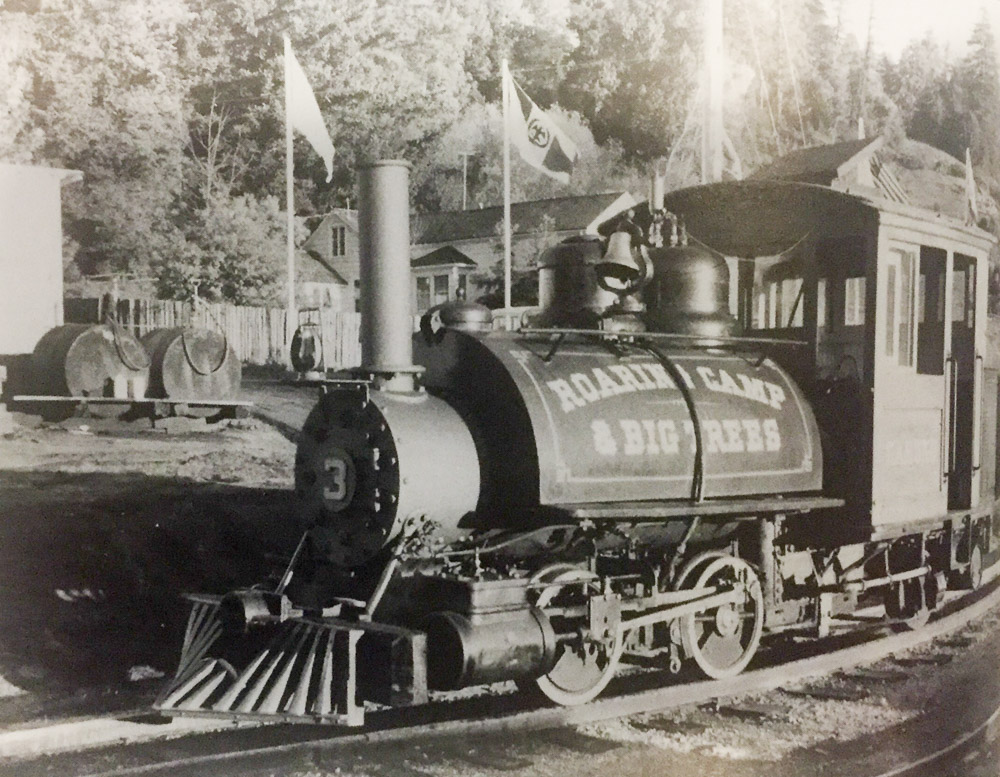
KAHUKU BALDWIN
Roaring Camp Railroads’ No. 3 engine, the Kahuku Baldwin, has a rich and colorful history dating back to its origins at the famous Baldwin Locomotive Works of Philadelphia, Pennsylvania. It was ordered in 1890 by the newly formed Kahuku Plantation Company on the island of Oahu to carry sugar cane from the fields to the mill at Kahuku. Upon completion of its construction, the 12-ton narrow-gauge steam locomotive was transported via sailing ship 14,000 miles around Cape Horn to her new home in Hawaii.
From 1890 until 1947, the tiny 0-4-2 saddle tank locomotive chugged busily between the tropical peaks of the Koolau Mountains and the crystal blue waters of the Hawaiian seas.
During her lifetime of service, the little steamer served under four flags: the Monarchies of King David Kalakaua and his successor, Queen Liliuokalani, the Republic of Hawaii and, ultimately, the United States Territory of Hawaii.
In 1947, the Kahuku Baldwin was retired and sold for display to the Sutro Museum at the Cliff House in San Francisco. Once again she was loaded aboard a ship bound for the city by the bay where she was placed on display for nearly two decades.
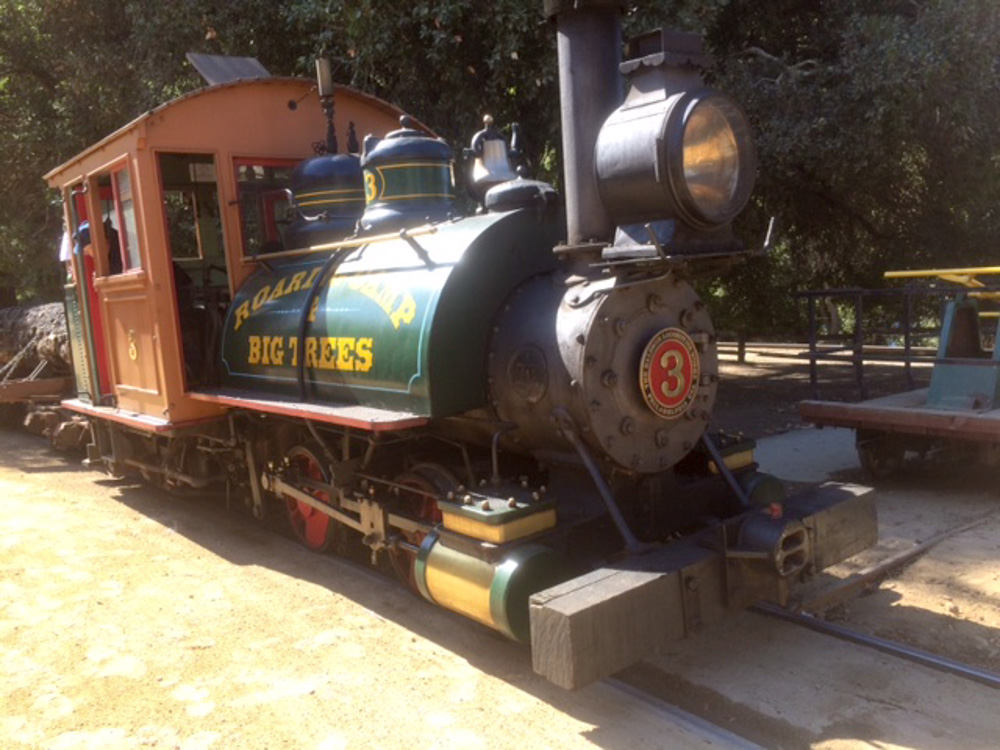
KAHUKU AT ROARING CAMP
In 1966, F. Norman Clark, President of the Roaring Camp & Big Trees Narrow-Gauge Railroad at Felton, Santa Cruz County, California, learned that the Sutro Museum was soon to be dismantled and the Kahuku was for sale. A quick trip to San Francisco revealed that the 76-year old steam locomotive was in good running order. The little engine was loaded aboard a heavy equipment truck and brought to her new home at Felton to become locomotive #3 on RC&BTNGRR’s scenic passenger train route through the redwoods of Santa Cruz County.
In 1968, a demand for larger steam locomotives to handle the booming passenger business of the RC&BTNGRR’s famous 8% grades (the steepest in western America) caused the little “Kahuku Baldwin” to be retired to standby duty. Today this historic locomotive is lovingly maintained and is occasionally enlisted to shuttle guests from an outer parking lot to the town of Roaring Camp during special events with rare excursions to Bear Mountain.

